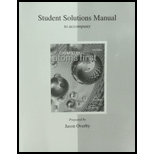
Concept explainers
Interpretation:
The molecular formula of the given compound has to be calculated.
Concept Introduction:
Ideal gas is the most usually used form of the ideal gas equation, which describes the relationship among the four variables P, V, n, and T. An ideal gas is a hypothetical sample of gas whose pressure-volume-temperature behavior is predicted accurately by the ideal gas equation.
The molar mass formula
Answer to Problem 11.84QP
Hence, the molecular formula is
If you determine the molar mass of the gas, you will be able to determine the molecular formula from the empirical formula.
Explanation of Solution
To calculate the moles of the compound.
The mole of the compound is calculated by plugging in the values of the given volume,
Pressure and temperature. The moles of the compound was found to be
To calculate the molar mass
The molar mass is calculated by plugging in the given weight of compound and moles of compound. The molar mass was found to be
To calculate the empirical formula, first we need to find the mass of
Since the compound only contains P and F, the mass of P in the 0.2324 g sample is:
The mass of
We can convert masses of P and F to moles of each substance.
The moles of each substance are calculated by plugging in the given weight of compound and molecular weight of compound. The moles of each substance was found to be
Thus, we arrive at the formula
To determine the molecular formula, divide the molar mass by the empirical mass.
Hence, the molecular formula is
The molecular formula of the given compound was calculated.
Want to see more full solutions like this?
Chapter 11 Solutions
Student Solutions Manual For Chemistry: Atoms First
- An organic compound contains C, H, N, and O. Combustion of 0.1023 g of the compound in excess oxygen yielded 0.2766 g CO2 and 0.0991 g H2O. A sample of 0.4831 g of the compound was analyzed for nitrogen by the Dumas method (see Exercise 129). At STP, 27.6 mL of dry N2 was obtained. In a third experiment, the density of the compound as a gas was found to be 4.02 g/L at 127C and 256 torr. What are the empirical and molecular formulas of the compound?arrow_forwardSilicon nitride, Si3N4, is a material that is used in computer chips as an insulator. Silicon nitride can be prepared according to the chemical equation 3SiH4(g)+4NH3(g)Si3N4(g)+12H2(g) If you wanted to prepare a surface film of Si3N4(s) that had an area of 9.0 mm2 and was 4.0 105 mm thick, what volume of SiH4 gas would you need to use at 1.0 105 torr and 775 K? The density of Si3N2 is 3.29 g/cm3.arrow_forwardPotassium peroxide is used to absorb the CO2 produced by the people in a space vehicle. 2K2O2(s)+2CO2(g)2K2CO3(s)+O2(g)If a person at rest exhales 3.0 L of air per minute and CO2 is 3.4% (by volume) of exhaled air, how many grams of K2O2 are needed per person for a five-day trip. Assume a temperature of 250 and 728 mm Hg pressure.arrow_forward
- For scuba dives below 150 ft, helium is often used to replace nitrogen in the scuba tank. If 15.2 g of He(g) and 30.6 g of O2(g) are added to a previously evacuated 5.00 L tank at 22 C, calculate the partial pressure of each gas present as well as the total pressure in the tank.arrow_forwardA 0.105-g sample of a gaseous compound has a pressure of 561 mm Hg in a volume of 125 mL at 23.0 C. What is its molar mass?arrow_forwardA sample of natural gas is 85.2% methane, CH4, and 14.8% ethane, C2H6, by mass. What is the density of this mixture at 18C and 771 mmHg?arrow_forward
 ChemistryChemistryISBN:9781305957404Author:Steven S. Zumdahl, Susan A. Zumdahl, Donald J. DeCostePublisher:Cengage Learning
ChemistryChemistryISBN:9781305957404Author:Steven S. Zumdahl, Susan A. Zumdahl, Donald J. DeCostePublisher:Cengage Learning Chemistry: An Atoms First ApproachChemistryISBN:9781305079243Author:Steven S. Zumdahl, Susan A. ZumdahlPublisher:Cengage Learning
Chemistry: An Atoms First ApproachChemistryISBN:9781305079243Author:Steven S. Zumdahl, Susan A. ZumdahlPublisher:Cengage Learning
 Chemistry: The Molecular ScienceChemistryISBN:9781285199047Author:John W. Moore, Conrad L. StanitskiPublisher:Cengage Learning
Chemistry: The Molecular ScienceChemistryISBN:9781285199047Author:John W. Moore, Conrad L. StanitskiPublisher:Cengage Learning Chemistry: Principles and PracticeChemistryISBN:9780534420123Author:Daniel L. Reger, Scott R. Goode, David W. Ball, Edward MercerPublisher:Cengage Learning
Chemistry: Principles and PracticeChemistryISBN:9780534420123Author:Daniel L. Reger, Scott R. Goode, David W. Ball, Edward MercerPublisher:Cengage Learning





